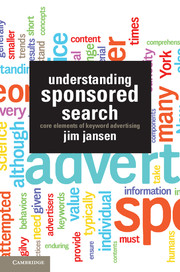Book contents
- Frontmatter
- Contents
- Preface
- Acknowledgments
- Notes on Terminology
- 1 A Context for Sponsored Search
- 2 Modeling the Process of Sponsored Search
- 3 Understanding Customer Intent for Keyphrase Selection
- 4 Sending Signals to the Customer with Ads
- 5 Understanding Consumer Behavior for Sponsored Search
- 6 BAM!: Branding, Advertising, and Marketing for Sponsored Search
- 7 Sponsored-Search Analytics
- 8 The Serious Game of Bidding on Keywords
- 9 Bringing It All Together in a Framework of Sponsored Search
- 10 The Future of Sponsored Search
- Glossary
- Index
- References
3 - Understanding Customer Intent for Keyphrase Selection
Published online by Cambridge University Press: 05 August 2011
- Frontmatter
- Contents
- Preface
- Acknowledgments
- Notes on Terminology
- 1 A Context for Sponsored Search
- 2 Modeling the Process of Sponsored Search
- 3 Understanding Customer Intent for Keyphrase Selection
- 4 Sending Signals to the Customer with Ads
- 5 Understanding Consumer Behavior for Sponsored Search
- 6 BAM!: Branding, Advertising, and Marketing for Sponsored Search
- 7 Sponsored-Search Analytics
- 8 The Serious Game of Bidding on Keywords
- 9 Bringing It All Together in a Framework of Sponsored Search
- 10 The Future of Sponsored Search
- Glossary
- Index
- References
Summary
The Database of Intentions is simply this: The aggregate results of every search ever entered, every result list ever tendered, and every path taken as a result. This information represents, in aggregate form, a place holder for the intentions of humankind – a massive database of desires, needs, wants, and likes that can be discovered, subpoenaed, archived, tracked, and exploited to all sorts of ends.
John Battelle, The Search: How Google and Its Rivals Rewrote the Rules of Business and Transformed Our Culture.When online consumers search for a frame shop, they input a query containing keywords into a search engine. It is these query terms, representing the desires and intentions of the searcher that form the basis of the sponsored-search effort.
- Type
- Chapter
- Information
- Understanding Sponsored SearchCore Elements of Keyword Advertising, pp. 30 - 59Publisher: Cambridge University PressPrint publication year: 2011



